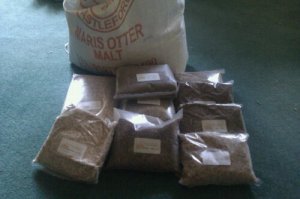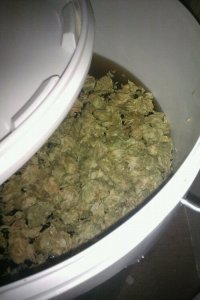
Last weekend I went to Chilled Cider, which is a tiny festival in a pub in Dorset. Unsurprisingly Sam and I skipped the cider and helped drink them dry of Harvest Pale Ale. I subsequently found out that it was Champion Beer of Britain last year, and very nice it was too. It got me thinking that I’d really like to brew a light, hoppy session beer. Much as I’m enjoying the Flashman IPA, at around 5.8% or so, it’s a bit much to have more than a pint or two. I aimed for under 4%.
The Citra hops that I got for the IPA are fantastic, so I’ve decided to go for a single hop Citra. This was my recipe, for 23 litre length.
Fermentables:
4kg Maris Otter
100g Crystal (for a bit of colour and body)
Hop schedule. All are Citra (13.3% AA)
90 min: 5g
20 min: 15g
10 min: 25g
Post-boil: 10g
The YoBrew calculator reckons that’s about 37 IBU. Previously I’ve worked out at about 70% efficiency, so I worked off that, resulting in predicted OG of 1.037, leading to about 3.9% ABV. However I seem to have improved my technique. These are from memory, but I think I got over 1.045. That’s about 85% efficiency! I guess I’ve improved my sparging technique. I diluted it down to around 1.039, which should give about 4%.
Previously I’ve had real problem with clarity of my beers. The Chamomile Lawn never properly cleared, while the IPA is only just clear now. I think I did better with the Beergerac, but that went bad so I didn’t check. I think I’ve done better this time. I added half a tablet of protafloc at 15 mins, and used a big sheet of (boiled) muslin to filter the hops and break material as I poured it into the fermenter. I also did better at making sure I’d waited til it was at a good rolling boil before adding the hops and starting the timings. I think I’ve got a better chilling technique worked out now too: bath full of cold water, with frozen water bottles in it. The pan goes in there, on a cooling rack so it’s not sitting on the bottom, and I leave the tap running slowly.
Anyway, the pic above is the wort that I sampled before it went into the fermenter (before pitching the yeast), after settling in the trial jar overnight. You can’t see it too well, but there’s lots of break material settling at the bottom and the wort itself is pretty much perfectly clear. Winner (so far)!



 The second brew I made, and the first with extract rather than a kit, was a witbier to which I added a big dollop of homemade marmalade. This was christened “Beermalade”. This weekend we brewed a winter warmer, and decided at the last minute to spice it up with some marmalade. I still have several jars of a very dark marmalade I made a couple of years ago, which also had a little rum in it. In the end we just added a whole jar, so we had to call it Winter Beermalade, to distinguish it from the wheat beer which I’ve renamed Summer Beermalade (and will try to recreate next year).
The second brew I made, and the first with extract rather than a kit, was a witbier to which I added a big dollop of homemade marmalade. This was christened “Beermalade”. This weekend we brewed a winter warmer, and decided at the last minute to spice it up with some marmalade. I still have several jars of a very dark marmalade I made a couple of years ago, which also had a little rum in it. In the end we just added a whole jar, so we had to call it Winter Beermalade, to distinguish it from the wheat beer which I’ve renamed Summer Beermalade (and will try to recreate next year).











 I love a good porter in winter, and as porter is at its best when matured, now is the time to get brewing. Proper porters in the 18th century got their complex flavours from the fact that maltsters were unable to create pale, uniform malts. The malts they used were all different colours, so to recreate this brewers often use several different types of malt in their porter. Not a fan of doing things by halves, I decided to go for ten malts in mine. Some of these are old-fashioned malts like amber and brown, with a little smoked malt to recreate some of the smokiness brought about by the way malts were kilned. Others are modern, such as melanoidin malt, a German innovation which allows the brewer to get some of the rich, deep maltiness found in Oktoberfest beers without the complicated decoction mashing normally required. The base malt is still the good old Maris Otter pale malt. Despite this, the predicted colour was almost black – it doesn’t take a lot of dark malt to get a very dark beer.
I love a good porter in winter, and as porter is at its best when matured, now is the time to get brewing. Proper porters in the 18th century got their complex flavours from the fact that maltsters were unable to create pale, uniform malts. The malts they used were all different colours, so to recreate this brewers often use several different types of malt in their porter. Not a fan of doing things by halves, I decided to go for ten malts in mine. Some of these are old-fashioned malts like amber and brown, with a little smoked malt to recreate some of the smokiness brought about by the way malts were kilned. Others are modern, such as melanoidin malt, a German innovation which allows the brewer to get some of the rich, deep maltiness found in Oktoberfest beers without the complicated decoction mashing normally required. The base malt is still the good old Maris Otter pale malt. Despite this, the predicted colour was almost black – it doesn’t take a lot of dark malt to get a very dark beer.





















